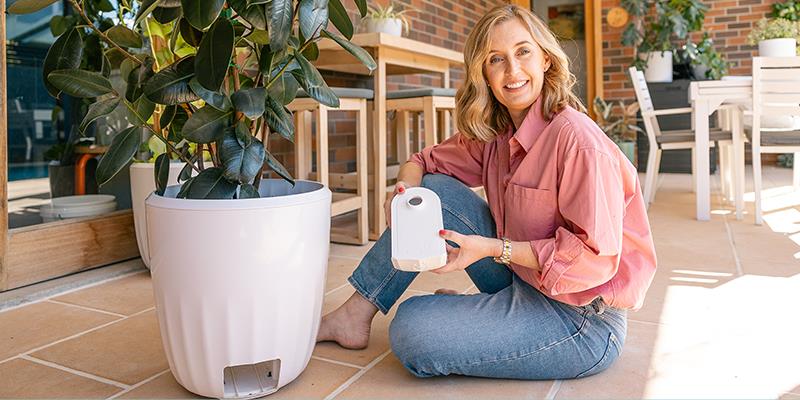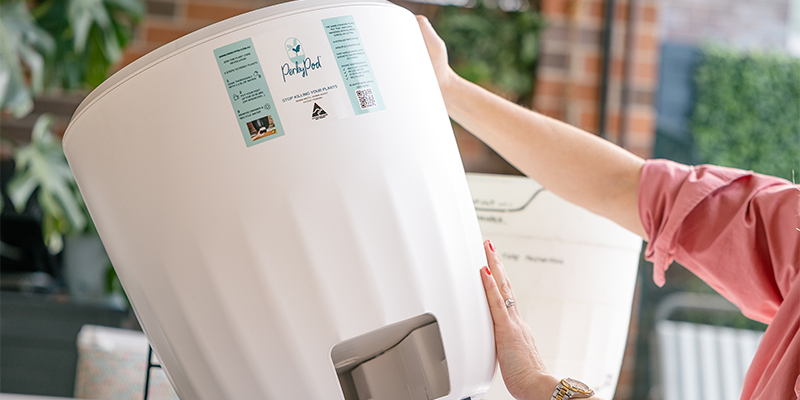There's no plant pot out there that has any functionality to help you keep your plant alive.
My name is Louise Burr and my job title is Chief Plant Mum of PerkyPod.
I wanted to be able to make a pot that had an integrated drainage and water catchment system so that everybody could just water their plants freely.
In our case for PerkyPod, the water is stored in a catchment drawer that is really easy to remove and tip out.
PerkyPod has a registered design, a trade mark and a patent pending.
I started thinking about IP right from the get-go.
The trade mark was definitely very, very early because I knew what I wanted to call it.
We had to do a quick name change. We went through the trade mark process for that first name. We received a letter that our trade mark had been opposed about 3 days before the end of the opposition period.
It wasn't the best timing because I'd just had my prototype made and I had had that name imprinted on the product.
Had I known that I really only needed to wait a couple more weeks to end the opposition period, I would have waited.
Don't invest in anything that has your name on it until it is protected with a trade mark.
The design right is really important to protect the aesthetics of how it looks because I do not ever want to see a product that looks like my baby on the shelves of a company that doesn't deserve to make a business out of profiting off my idea.
And the patent pending aspect is a real commercial advantage, not just peace of mind for me, but commercially, down track for potential investors.
I was fortunate enough to find an industrial design team to work with locally here in Newcastle, and they specialise in taking things from concept through to an actual product.
And I love the feeling that, yeah, I've made something that's worth protecting the aesthetics of it. It was pretty cool, I always think back to the first night when I started sketching my idea and it hasn't really changed too much from that initial concept.
If you can't reduce the risk of imitations then why are you even here?
Indoor plant lover Louise Burr was always searching for a pot that was functional as well as stylish, but the self-watering pots on the market never lived up to their claims.
She began to imagine a pot that solved all of the common problems that lead to the demise of much-loved house plants. And then she created it.
Louise’s background as a Royal Australian Air Force civil engineer, her passion for interior design, and 3 years of research and development led to PerkyPod.
The award-winning, Australian-made product has a trade mark, design right and a patent pending.
Clever design in every detail
Every detail on the PerkyPod has been researched, tested and thoughtfully added.
On the outside, PerkyPod looks like a modern, white plant pot. The innovation is on the inside as the world’s first self-draining planter.
An integrated drainage, filtration and water catchment system catches any excess water and keeps it in a removable, built-in drawer. This means you can water your plants as much as you like, without having to move your plant to the sink or the lawn to avoid drips.
There’s also an option to add wheels, which makes it easy to move the plant if it needs more light, to sweep the floor, or to change the look of a room.
The PerkyPod design solves the problem of pots sitting in stagnant water, attracting bugs and leading to root rot. It means even novices and time-poor people can enjoy thriving indoor and outdoor plants without any stress or mess.
It was important to Louise that the pot looked great, too. She consulted interior designers on the best size and colour and studied interior trends.
Louise’s determination to bring her vision to life consumed every spare minute between her air force career and busy family life with 3 kids.
‘I used to wonder why no one had invented this sooner, but once I got into the process, I realised why ... There wasn't a lot of downtime trying to make it work in those early days of R&D.’
Protecting innovation with IP rights
With her dream pot sketched and looking to take the next step, Louise mentioned it to a friend on the sidelines of a kids’ soccer game. It turned out the man’s wife was a designer who had an idea copied years before. He warned her that good ideas could be stolen.
The first IP right Louise went about protecting was a trade mark, because she had a name for the pot that she loved. But it didn’t go to plan.
After a trade mark is examined, there is a 2-month period when anyone can oppose it. Louise had started printing the name on prototypes and promotional materials. Then 3 days before the opposition period ended, a large company opposed the trade mark.
Louise decided to start over with a new name, but the experience was costly. She had to throw out some sample products, pay for a logo re-do and wait for a new name to be trade marked.
Next, Louise applied for a design right, which went more smoothly. Working with an IP attorney and graphic artist, her design was eventually made official on the Australian Design Search Database.
Finally, the attorney supported Louise with her patent, identifying the aspects of her design that were new, useful and inventive. Among the many benefits of a patent, Louise says, is a signal to customers, potential investors and innovation award competitions.
‘There are a lot of early adopters out there,’ she says. ‘They like to seek new products and it's a good assurance for them that they've found a new way of doing things – something that hasn't been seen before.’
PerkyPod won the 2024 Australian Good Design Award for Homewares and became a Finalist in the Finder Innovation Award for best product innovation.
An entrepreneurial new chapter
Louise now proudly claims the job title of ‘Chief Plant Mum’ after a trailblazing 25-year career in the air force.
In 2001, she was the only woman civil engineering graduate of the Australian Defence Force Academy. Then in 2018, she became the first Australian woman to be appointed chief engineer for the Middle East region.
In her last project, Louise was the acquisition facilities lead for a $1.5 billion F-35 Joint Strike Fighter jet project. Her work was recognised with the 2021 Women in Defence Award for engineering and commendations.
Her talents for problem solving, working with technical specialists and having the resilience to keep going despite challenges have all been assets for PerkyPod.
Louise says she was fortunate to step into a new career that brings her so much joy.
‘You really have to find something that brings you a sense of purpose and aligns with your values,’ Louise reflects. ‘The transition can be really, really tough and a lot of veterans do have a tough time of it. I was not immune to that.’
Her favourite part of the job is reading feedback from delighted customers. She replies to every email.
‘I would say every third review we get is a customer saying they have never kept a plant alive until now,’ Louise says.
‘It's why we keep going. There are really hard moments when launching a product and starting your own business around it. Those moments make it worth it.’
Learn more about PerkyPod by visiting the website.
Visit the PerkyPod website

